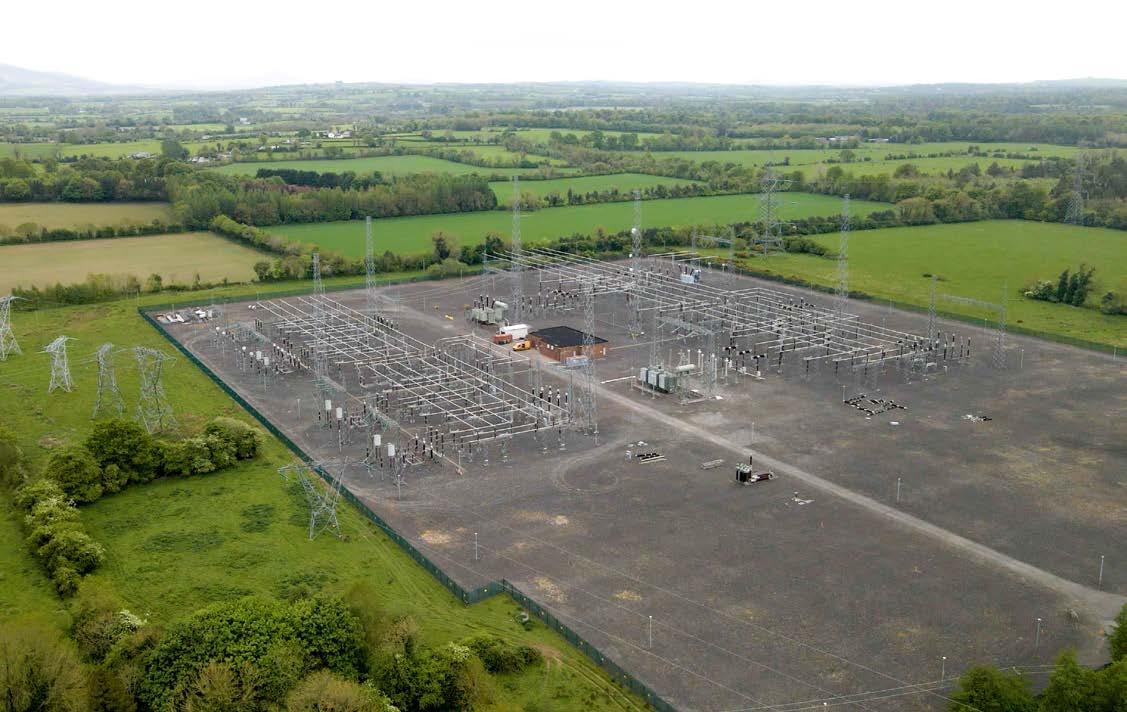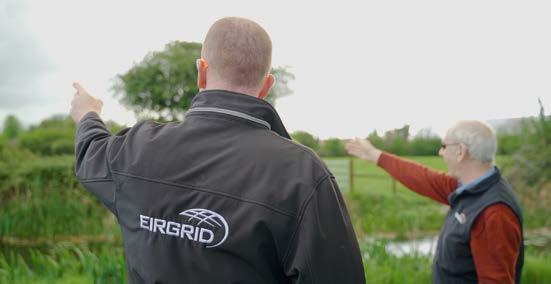
5 minute read
EirGrid

Securing the transition for a cleaner energy future
EirGrid has a challenging role to play in leading the secure transition to an electricity grid powered by renewable energy.
The national electricity grid operator needs to add more energy from renewable sources to the power system over the next eight years to meet the Government target of up to 80% of electricity coming from renewable sources by 2030.
Achieving this target, while also ensuring the security of electricity supply will require a great deal of planning and a collaborative approach with stakeholders. Along with this, it will require meaningful engagement with communities and businesses to gain public acceptance for grid infrastructure projects.
Every minute of every hour the grid is transporting energy from where it is generated to where it is needed, powering the economy, heating homes via the distribution network, and ensuring local economies thrive.
To make sure this continues, EirGrid is working to develop the grid to meet electricity demand and is currently planning the latest grid upgrade in Kildare which will see a high-capacity underground electricity connection being developed.
The Kildare-Meath Grid Upgrade will see a 400kV underground connection between Dunstown substation near Two Mile House, and Woodland substation near Batterstown in Meath.
The upgrade will help to more effectively transfer power to the east of the country and distribute it within the electricity network in Kildare, Meath and surrounding counties. It will also help to facilitate the integration of renewable energy on the grid by strengthening the network and help meet the growing demand for electricity in the region.
The project has identified a best performing route option which will avoid villages and the town centres of Kilcock, Clane, Prosperous and Sallins.
EirGrid’s key objective is to avoid impacts to communities where possible, and the route was chosen as it is the least disruptive to communities and has the earliest project completion date compared to previously proposed routes. This point of the project was reached with the input of local businesses, communities, landowners, stakeholders and members of the public, along with a dedicated project team carrying out detailed assessments and consultation.
Speaking about reaching the key milestone in the project earlier this year, Michael Mahon, chief infrastructure officer said: “We want to thank the business communities along the route who continue to engage with the project team. Stakeholder feedback has been vital in determining the best performing route option.”
Developing projects such as the Kildare-Meath Grid Upgrade will contribute towards achieving Ireland’s 2030 goals, but the ambition to reach these, and the transition to net zero carbon emissions by 2050 will not be without challenge.
Balancing the security of supply concerns Ireland faces, along with competitiveness/cost and increased generation from renewables and other low carbon technologies are factors EirGrid is acutely aware of.
The grid operator is committed to leading Ireland to a cleaner energy future, while maintaining a safe, secure and reliable supply of electricity.
EirGrid will continue to focus on its role in transforming the power system for future generations to ensure that the electricity system and the market make its contribution to achieving a decarbonised society.
Understanding the crucial need to take on more renewables onto the grid, and having a central part to play in delivering on Ireland’s clean energy ambitions, EirGrid is pushing the boundaries of the possible integration of world-leading volumes of electricity from renewable sources onto the power system, while carefully managing security of supply.

Pushing those boundaries has resulted in three quarters of the electricity flowing on the electricity grid at any point in time now coming from variable renewable sources, such as wind, following the completion of a ground-breaking project by EirGrid.
The Ireland and Northern Ireland power system is the first in the world to reach this level, overcoming major technical challenges associated with integrating electricity from wind farms, solar farms and interconnectors that link it with other countries.
EirGrid had previously imposed a cap of 70% on the amount of variable renewable generation on the grid at a given time. This has now been raised to 75% following a successful 11-month trial.
To put the achievement into context, wind, solar and interconnectors have very different technical characteristics to conventional fossil-fuel powered generation. This creates challenges in maintaining the stability and security of the power system forcing EirGrid to limit the amount of variable renewables on the grid in the past. This is a hugely significant milestone and a critical step in the decarbonisation of the electricity sector on the island of Ireland. It marks the culmination of an elevenyear programme of work by EirGrid and its partner SONI in Northern Ireland, as well as by stakeholders from right across the industry.
It is with this world-leading ambition, that EirGrid continues its work planning for the future of a cleaner, stronger and more flexible electricity grid. This ambition sees EirGrid also strive to get the most out of the grid through new technologies and to develop new and necessary grid infrastructure.
As evidenced through the recent Shaping Our Electricity Future roadmap, which came from a comprehensive public consultation in 2021, EirGrid is planning 40 new grid infrastructure projects, representing a total investment of over €1bn.
This roadmap will continue to be reviewed in order to meet the demands on the country’s electricity supply and to support the growing economy. The final roadmap contains a blended approach, looking at grid development from an economic, technical, social acceptance and deliverability perspective and seeks to minimise impacts on communities, while still delivering on the renewable ambitions.
Again, it is with this grid development approach that the Kildare-Meath Grid Upgrade project focuses heavily on minimising disruption to people and businesses along the project route.
Through continued engagement with members of the public, landowners, local authorities and Kildare Chamber, EirGrid understands what needs to be considered while developing the project, and, how it can deliver meaningful community benefit to the area where infrastructure is hosted.
EirGrid is not just committed to developing world-leading infrastructure through its capability and resources, but to leaving a positive legacy in communities after project delivery.
This will be achieved through the Kildare-Meath Grid Upgrade Community Forum which acts as a consultative body to EirGrid throughout the project’s development.
It is the belief that through sustained partnerships, such as Kildare Chamber and other stakeholders, solutions that are ambitious and innovative will be identified and will help EirGrid lead the secure transition of Ireland’s energy sector.


